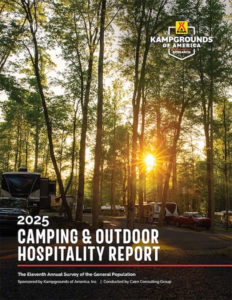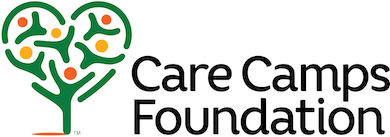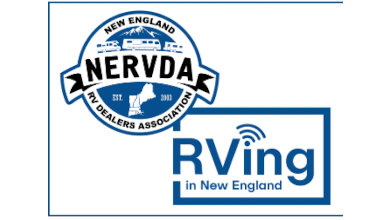KOA Report Reveals Strong Growth in Camping Industry
Camping has continued to evolve to meet the needs of the influx of new and experienced outdoor enthusiasts in the wake of the COVID-19 pandemic. Despite these changes, one thing remains clear: camping remains an affordable travel option. This insight comes from a new report by Kampgrounds of America (KOA). The 2025 Camping & Outdoor Hospitality Report highlights the industry’s resilience, even amid economic uncertainty.
 “Today, 1 in 4 leisure travelers consider themselves campers,” said Toby O’Rourke, president and CEO of KOA. “We’ve seen tremendous growth in participation over the past five years. While camping was down slightly year-over-year, we anticipate a resurgence in returning travelers to camping this year, with 72% of campers believing camping is the most cost-effective travel option.”
“Today, 1 in 4 leisure travelers consider themselves campers,” said Toby O’Rourke, president and CEO of KOA. “We’ve seen tremendous growth in participation over the past five years. While camping was down slightly year-over-year, we anticipate a resurgence in returning travelers to camping this year, with 72% of campers believing camping is the most cost-effective travel option.”
Key findings from the report highlight generational differences, camping preferences, the financial impacts of camping on local communities and similarities between pre-pandemic campers in 2019 and campers today. Among other noteworthy insights, the report also provides an in-depth analysis of traveler sentiment toward the economy and 2025 traveler intentions.
An Evolution & Reset of the Industry
- Over 11 million new households camped in 2024 compared to 2019, creating a very noticeable evolution in camping participation.
- New campers accounted for approximately 5% of all campers in 2024, mirroring the percentage seen in 2019. These campers are younger and prefer locations that offer a variety of amenities and services, leaning toward private campgrounds and glamping resorts over more rustic camping spots.
- Campers are attracted to closer, more flexible escapes, with 62% choosing weekend getaways and 44% staying closer to home.
- Nostalgia is driving campers back to the basics. 26% of campers want to reconnect with family traditions such as making s’mores and telling campfire stories.
Camping & the Economy
- Camping spending reached $61 billion in 2024, injecting vital resources into local economies.
- Daily spending rose to $200 per day per household, up $43 from 2023. Glampers and Gen Z spend the most, averaging $251 and $266 per day.
- 8 in 10 campers say rising travel costs have impacted their trips, but instead of canceling plans, they choose to prioritize low-cost activities like campfires, hiking and nature walks.
- 65% of campers plan to spend the same or more on travel than last year. Canadians are feeling the least optimistic, with 31% saying they plan to spend less, compared to 24% of Americans.
Sought-After Travel Experiences
- Campers and leisure travelers alike are focusing on experiences that enhance their overall well-being, expressing a desire to slow down and be fully present in the moment.
- Experiencing wellness by water is a top travel trend, with 57% of campers and 53% of leisure travelers citing that walking on a beach or relaxing near a body of water helps their overall well-being.
- Solo camping is on the rise, with 1 in 5 campers taking their first solo trip in 2024. Gen Z and millennials are most interested in solo trips this year.
- Camping is seen as a multigenerational activity. One-third of all campers feel camping with kids is more relaxing than participating in other forms of travel, and 22% are camping with extended family members.
“This year’s report highlights a dynamic reset in the camping landscape, where new generations and experienced campers alike are embracing a more flexible, experience-driven approach to outdoor travel,” said O’Rourke. “With increased interest in amenities, service, wellness and family bonding, camping is evolving into a diverse and accessible option for all travelers. Despite economic pressures, it’s clear that the outdoor hospitality industry provides significant value for personal well-being and contributes positively to local communities, ensuring its continued strength and resilience.”
To view the full 2025 Camping and Outdoor Hospitality Report, visit KOA.com.
Survey Methodology
The survey, commissioned by Kampgrounds of America, is designed to provide a detailed accounting of the U.S. and Canadian camping markets. This effort, on an overall basis, will be compared to a benchmark incidence study conducted in 2014 and followed up in each year up to the present. The results of the most recent iteration of the Outdoor Hospitality Report are based on a total of 4,119 surveys completed among a random sample of U.S. (n=2,912) and Canadian (n=1,207) households. Within the U.S. sample of households, results are stratified by Census Region: Northeast (n=728), Midwest (n=726), South (n=731), and West (n=728). Overall, a sample of 2,912 households is associated with a margin of error of +/-1.82 percentage points, while a sample of n=1,207 Canadian households is associated with a margin of error of 2.83 percentage points. Other surveys and sources of information: KOA Monthly Research Report: April 2022 to January 2024, Sponsored by KOA. All surveys were completed online via an outbound solicitation sent to a randomly selected cross-section of U.S. and Canadian households. In order to calculate overall incidence, the sample of respondents was statistically balanced to ensure that the results are in line with overall population figures for age, gender identity, and ethnicity. Some results may not add to 100% due to rounding.


